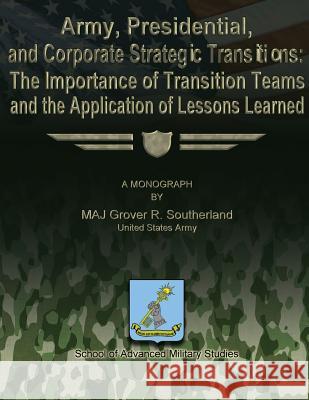Army, Presidential, and Corporate Strategic Transitions: The Importance of Transition Teams and the Application of Lessons Learned » książka
Army, Presidential, and Corporate Strategic Transitions: The Importance of Transition Teams and the Application of Lessons Learned
ISBN-13: 9781479194094 / Angielski / Miękka / 2012 / 78 str.
Army, Presidential, and Corporate Strategic Transitions: The Importance of Transition Teams and the Application of Lessons Learned
ISBN-13: 9781479194094 / Angielski / Miękka / 2012 / 78 str.
(netto: 64,40 VAT: 5%)
Najniższa cena z 30 dni: 68,00
ok. 16-18 dni roboczych
Bez gwarancji dostawy przed świętami
Darmowa dostawa!
Strategic leader transitions constitute narrow windows of opportunity marked by high pressure, high expectations and general lack of organization awareness for many new leaders. During the transition period, an incoming leader must effectively utilize the existing time to develop a keen understanding of the organization and its environment while developing strategies for organizational success. If managed properly, transitions can enable organizational improvement in a number of ways. On the other hand, poorly managed leader transitions have significant ramifications. The Army's transition team methodology is excellent in assisting strategic leader transitions. Without transition teams, it is unlikely that any incoming commander, regardless of experience, could develop an equivalent situational understanding or command strategy. Thus, transition teams are important for the Army because they provide essential assistance to strategic leaders although few are aware of the Army's transitional methodology. This monograph fills an existing literature gap on military transitions while reinforcing the importance of Army transition teams. Its purpose is to inform readers about Army transition teams to include its general processes and products created. This monograph captures key aspects of the Army's methodology based upon first-hand experience by the author during the CG TRADOC Transition Team in the fall of 2005. After modeling the CG TRADOC transitional processes and products, the monograph explores the environment and lessons learned from presidential and corporate transitions in order to identify and incorporate relevant lessons into the Army transition process and develop recommendations for improved transition team operations in the future. The methodology traces critical elements of the environment for both presidential and corporate transitions. It captures lessons learned in the form of best practices, critical outcomes and common pitfalls associated with each type of transition. Identification of commonalities enables comparison of the lessons learned and the refinement and improvement of the modeled processes and products. The resulting transition model provides both products and processes based upon an improved understanding of the lessons learned from strategic leader transitions in other environments. The monograph concludes with recommendations for improved future Army transition operations that include codifying the Army's transitional process and training it in the AMSP program.
Zawartość książki może nie spełniać oczekiwań – reklamacje nie obejmują treści, która mogła nie być redakcyjnie ani merytorycznie opracowana.











